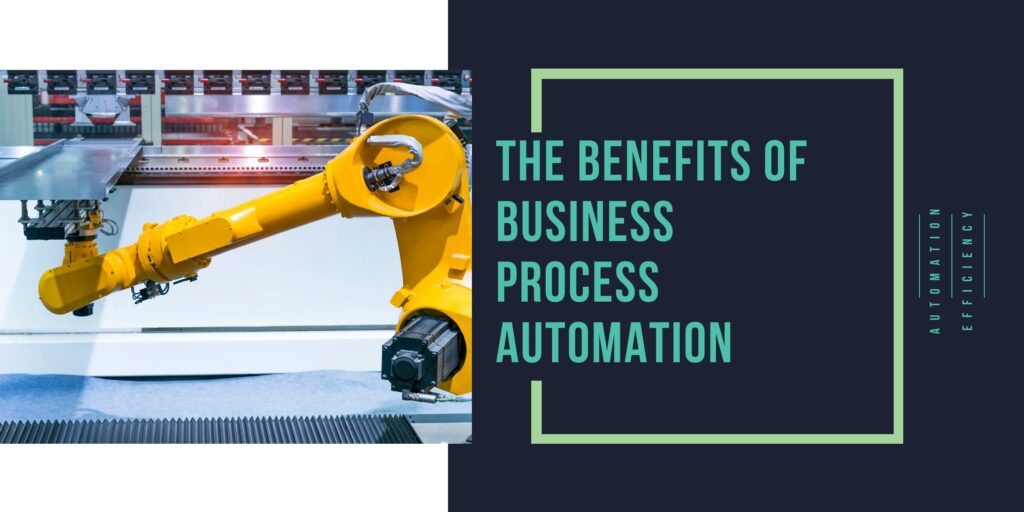Unleashing Efficiency: How Business Process Automation Transforms Operations for Success
Automation is the buzzword taking the business world by storm. Companies across various industries are increasingly automating their internal processes and reaping the benefits of a lean, efficient operation. Business process automation (BPA) involves the use of advanced technology to streamline and automate routine, repetitive business tasks and simplify complex processes. This can range from automating data entry and invoicing to more complex workflows such as customer service management and supply chain operations.
While many businesses still rely on manual processes, they run the risk of human error, lack of transparency, and inefficiency. These manual processes can be time-consuming and prone to mistakes, ultimately affecting a company’s bottom line. In contrast, BPA reduces errors, speeds up processes, enhances data accuracy, and offers better compliance with industry regulations.
In this blog post, we will explore the numerous benefits of business process automation and why it is the key to growth and success in today’s fast-paced business environment. We will delve into how BPA can lead to cost savings, improved productivity, and higher employee satisfaction by allowing staff to focus on more strategic tasks. Additionally, we’ll discuss real-world examples of companies that have successfully implemented BPA and the impact it has had on their operations. By understanding the transformative power of automation, businesses can position themselves for long-term success and stay ahead of the competition.
Benefits of BPA for Business Leaders and Customers
Business process automation brings a host of advantages not only to business leaders but also to customers. For business leaders, BPA translates to significant cost reductions by minimizing manual, labor-intensive tasks and reducing the likelihood of costly errors. Automation ensures that processes are executed consistently and accurately, thereby improving the reliability of operations. This leads to better decision-making as leaders can leverage real-time data and analytics to gain valuable insights into their business performance. Furthermore, BPA enhances scalability, allowing companies to handle increased workloads without a proportional increase in resources.
From a customer’s perspective, BPA leads to a higher quality of service. Automated processes typically result in faster response times and more consistent interactions, whether it’s processing orders, responding to inquiries, or managing customer support. This level of efficiency and reliability fosters greater customer satisfaction and loyalty. Additionally, BPA ensures that sensitive customer data is handled securely and compliantly, building trust and confidence in the business. Overall, by adopting BPA, businesses can create a more dynamic and responsive operational framework that benefits both internal stakeholders and external customers.
Real-World Examples of BPA Success Stories
Several companies have embraced BPA and witnessed tangible improvements in their operations. For instance, General Motors (GM) implemented robotic process automation (RPA) to streamline its finance processes, leading to a 95% reduction in manual effort and $2 million in savings. Similarly, global logistics provider DHL leveraged BPA to automate shipment tracking and reduce transit times by up to 50%, resulting in customer satisfaction rates reaching an all-time high.
Another notable example is that of multinational technology company Cisco, which used BPA to standardize its sales processes across multiple divisions, resulting in a 30% increase in sales productivity and $1.5 billion in revenue growth. These success stories highlight the potential impact of BPA on various aspects of business operations, from cost savings and efficiency to customer satisfaction and revenue growth.
Business process automation offers substantial benefits for companies looking to stay competitive. By automating routine tasks, reducing errors, and improving reliability, businesses can free up resources and focus on strategic initiatives that drive growth and innovation. Additionally, BPA leads to better decision-making through real-time data insights and enhances customer satisfaction by streamlining processes and improving service quality.
Now, let’s look at 4 key areas where BPA can help you.
Visibility to Key Metrics:
One of the primary advantages of automation is that it provides visibility into key metrics and KPIs. With a real-time view of processes and performance, key stakeholders can make informed decisions to improve processes, resolve bottlenecks, and optimize operations. Automating your internal processes enables your team to capture, analyze, and act on data quickly in order to make critical decisions that help to move the business forward.
By leveraging advanced analytics and reporting tools, automation allows for the continuous monitoring of performance metrics. This not only helps in identifying inefficiencies but also facilitates proactive management of potential issues before they become critical. Furthermore, it empowers employees by providing them with the necessary information and insights to focus on strategic initiatives rather than spending time on repetitive tasks. As a result, the organization can achieve higher productivity levels, better resource allocation, and sustained growth over time.
Eliminate Human Error:
Manual processes are highly prone to errors, which can lead to costly mistakes, unnecessary delays, and poor customer service. These errors might include data entry mistakes, miscommunications, or forgotten tasks, all of which can have significant repercussions on a business’s efficiency and reputation. Automation eliminates these issues by automating processes, reducing the risk of human error, and increasing accuracy, consistency, and reliability. With automated systems, tasks are performed uniformly and according to predefined rules, ensuring that every action is carried out precisely as intended. Additionally, with the use of advanced technologies like machine learning and AI, processes can even be optimized and improved based on historical data and analytical insights. This means that as more data is collected, the system can learn and adapt, continually enhancing its performance and offering even greater accuracy and efficiency over time. Such advancements not only streamline operations but also free up human resources to focus on more complex and strategic tasks, ultimately driving growth and innovation.
Increase Productivity and Efficiency:
Automation can help to increase productivity and operational efficiency by streamlining manual and complex tasks and freeing up staff time for more important activities. By automating routine processes, businesses can minimize human error, ensure consistency, and expedite workflows. For example, tasks like data entry, invoice processing, and customer service inquiries can be handled more efficiently through automation, allowing employees to focus on more strategic initiatives. BPA (Business Process Automation) can help to reduce processing time, which means that your team is able to complete more work in less time. This efficiency gain can lead to faster turnaround times, better customer satisfaction, and increased capacity for handling higher volumes of work. Additionally, automation can provide valuable insights through data analytics, helping to identify bottlenecks and areas for improvement in processes. Once your team is freed up from repetitive tasks, they can focus on higher-value projects, strategy, and innovation. This shift can foster a more dynamic and motivated workforce, driving the organization toward its long-term goals, such as expanding market share, improving service quality, and enhancing overall competitiveness. Automation, therefore, not only optimizes current operations but also lays the groundwork for sustainable growth and adaptability in a rapidly changing business environment.
Increase Customer Satisfaction and Turnaround Time:
Automation helps to improve customer satisfaction by ensuring that processes are completed accurately, efficiently, and speedily. This can lead to shorter turnaround times, better quality customer service, and a better overall customer experience. For instance, automated systems can handle repetitive tasks such as order processing, billing, and customer inquiries, freeing up human employees to focus on more complex and personalized interactions. By providing better customer satisfaction, you improve brand loyalty and increase the likelihood of repeat business from your customers. Moreover, satisfied customers are more likely to provide positive reviews and referrals, further enhancing your company’s reputation and attracting new clients. Investing in automation can also result in cost savings, as it reduces the need for manual labor and minimizes the risk of human error. In the long run, this contributes to greater operational efficiency and profitability, making automation a strategic priority for businesses aiming to thrive in a competitive market.
Reduce Costs and Attrition:
Implementing an automated system can help to significantly reduce overall operating costs, including labor, administrative, and operational expenses. By automating repetitive and time-consuming tasks, your team can focus on more strategic activities that add value to the business. Additionally, automating your internal processes can reduce team burnout by eliminating mundane tasks, which in turn improves morale and job satisfaction. Over time, this positive work environment can lead to a lower attrition rate, as employees are more likely to stay with a company that invests in their well-being and development. Given these multifaceted benefits, investing in automation is a smart, long-term strategy for reducing costs, enhancing employee retention, and driving sustainable growth for your organization.
How to Get Started with Business Process Automation
To embark on the journey of business process automation (BPA), it is critical first to conduct a comprehensive analysis of your current workflows. Begin by identifying repetitive, time-consuming tasks that are prone to human error or do not significantly contribute to strategic objectives. Document these processes in detail, noting any pain points and inefficiencies. Engage relevant stakeholders, including team members who are directly involved in these tasks, to gain insights into the nuances and specific challenges of each process. This collaborative approach will provide a clear understanding of the groundwork that needs to be laid for successful automation. Conducting a detailed analysis not only helps in selecting the right processes for automation but also ensures that the chosen processes align with the overall business objectives.
Once you have identified the processes that can benefit most from automation, the next step is to evaluate and select appropriate BPA tools and technologies. There is a plethora of automation software available, ranging from simple task automation tools to sophisticated platforms that integrate artificial intelligence and machine learning capabilities. Consider factors such as scalability, ease of integration with your existing systems, user-friendliness, and cost when choosing an automation solution. It is also essential to develop a robust implementation plan that includes timelines, resource allocation, and training programs for your team. Ensure you have a feedback mechanism in place to continuously monitor the effectiveness of the automation and make adjustments as needed. By systematically analyzing, selecting, and implementing the right BPA tools, organizations can pave the way for enhanced efficiency, reduced costs, and sustained long-term growth.
The advantages of business process automation are undeniable. Companies that invest in automation can experience reduced costs, enhanced customer satisfaction, and increased efficiency. By minimizing human error, boosting productivity, and accelerating turnaround times, automation empowers businesses to concentrate on their core strengths—innovating, expanding, and delivering exceptional customer experiences.
Automation not only cuts down on repetitive and time-consuming tasks, allowing employees to focus on more strategic activities, but it also ensures consistency and quality in process execution. Imagine routine tasks, such as data entry or invoice processing, being handled seamlessly without the risk of human error or delays, freeing up your team to drive more value-added initiatives.
Furthermore, automation can provide valuable insights through data analytics, helping businesses make more informed decisions and adapt quickly to market changes. This technological advancement can lead to greater scalability, allowing companies to grow without the proportional increase in operational costs.
If your business is ready to embrace automation, reach out to our consulting experts today and let us help you transform your operations. Our team can guide you through the process, ensuring a smooth transition and helping you achieve the maximum benefits of automation.







